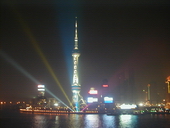 |
 |
 |
| Home |
| Contact Us |
| Prices |
| Technical Data |
| Maintenance |
| FAQ |
| History |
| Parts |
| Shipping |
| License for Shanghai |
E-mail
us shanghaisidecars@gmail.com |
Advertisement
|
The best way to explore Beijing and the surrounding areas. Geographically Beijing is protected by a mountain range on the north. This mountain range is where the Great Wall runs from the east all the way to XinJiang. To the north is the grasslands where the emperor use to hunt. To the west is the desert. In the surrounding areas of the Great Wall, aside from the mountains, there are waterfalls, fish farms, river rafting, horse riding, camping areas, holiday resorts, and lots of winding road and beautiful scenery. I would like to invite anyone that is interested in motorbiking in China on a sidecar to join our friends in Beijing for a weekend ride. Check out some of the pix on my site here and you will see why. Own a CJ750 in Shanghai - join a ride in Beijing ... only at Shanghai Sidecars. |
| German
origin
Basically Hitler needed them cause he was not allowed to build vehicals used for war purposes. These vehicals had MG mounts and Grenade launchers mounted on them and could mobilize soldiers quickly. The Chang Jiang 750 sidecar is a spin off of a great invention by the Germans like the Mauser 98, Walter P38, these bikes last forever. Early 1930's The rising German administration of the 30's, needed military equipment, but the terms of surrender imposed under the Treaty of Versailles at the end of World War I prohibited Germany from any form of military vehicle production, including large capacity motorcycles and sidecars. Germany developed a strategy to get around the restrictions by pursuing joint ventures with Russia. This was achieved by the signing of a 7 year trade agreement known as the Molotov-Ribbentrop pact. It was signed in Moscow on 23 August, 1939, by the Soviet foreign minister Vyacheslav Molotov and the German foreign minister Joachim von Ribbentrop). There was something in it for both sides, Russia had already recognized that German technology was far superior to theirs, and Germany needed the production hardware.
Russian Allies The Russians were allies to Germany prior to war so Germans gave them the dies to make their own sidecars. Just what Statlin needed with a bit of modification came the URALs and Depners. Now you can tell these bikes are loved by some of the greatest leaders that lived. Prior to the German invasion of Russia, the Russians are one point were allies with the German. There are two versions of this story, one the Germans gave some blueprints to the Russians who evolved the motorcycle to the Dnper and Urals. Many versions of these sidecar motorcycles had two wheel rear drive thus allowing it to move through the roughest terrain, snow and ice. Russia retained certain BMW tooling and designs for the BMW R71 motorcycle, and the Russian militarized R71 versions were designated the M72. This was almost identical to the BMW R71, and also featured the familiar horizontally opposed, 746 cc flat twin, side-valve engine.
The Russians were great allies of the Chinese people and during the communist revolution era of the 1950’s and that takes us to the next evolution of the sidecar motorcycle.
One can ou can say from one great man to another - Statlin gave it to Mao. The Chinese made millions of this bike and in the 1960s and 1970s they were everywhere in China. The BMW R71/ M72 was renamed the "Chang Jiang 750" which became the CJ750. During 1950, the Chinese "Peoples Liberation Army Beijing No.6 Automotive Works" had been attempting to develop a suitable military motorcycle by "reverse engineering" a Zundapp KS500 military motorcycle. The Chinese KS500 based machines entered production in 1951, and in total 4248 machines were built before responsibility for the manufacture of military motorcycles was transferred to Hongdu Machinery Plant and the Xinjiang Machine Plant. Both of these factories are subsidiaries of the State-run aeronautic manufacturing industry to this day.
Since the start of the use of the Chang Jiang 750 sidecar, the PLA ordered 30,000 of these bikes every year. Thus from the start of production in 1956 till 2005 over 1.5 million Chang Jiang 750 sidecars were built. Now, the Chang Jiang 750 is still making history…..though some might be far fetched truths, there people making up stories about about how hard they are to find, or that they have the original "genuwine" article, or that there is an exclusive right to distribute, these bikes are available all over Beijing and many parts of China. Others like us just love these bikes cause they are fun, easy to own, cheap, and importantly we hope you can own one too. Do your research, depending on who's story you believe you can own one of these bikes for less than 10,000RMB or up to 100,000RMB. |